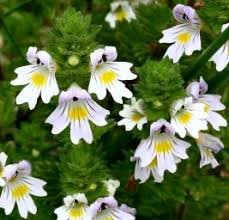Trendy Wine & Chupacabra Vibes- Eyebright
Hello and welcome back to another week of Rooted! This week I am coming at you with a plant sure to get your peepers popping- eyebright..if I accidentally slip up and say bright eyes. Please know I read all of “a series of unfortunate events” in like 4th grade and have only been deeply captivated by sad white men longing for something ever since.
But enough about your deeply flawed host, lets get back to plants.
Eyebright’s latin name is Euphrasia is actually a collection of 215 different species- but today we’ll mostly be discussing them broadly, with a few specifics tossed in where I see fit.
Eyebright is a member of a plant family we haven’t talked about on the show yet- Orobanchaceae! These guys are mostly parasitic plants, with the most famous members of the family being broomrape (unfortunate name), indian paintbrush, and lousewort.
Like I said- most of the plants in this family are parasitic- some more than others, but all of them basically sink their creepy little fangs into other plants root system and take their nutrients directly from the source, which honestly made me think of chupacabras biting the ankles of goats?? So now the two are forever fused in my mind.
Outside of some kind of freaky feet stuff, these guys tend to have pretty simple root systems, with the ones who aren't fully reliant on hosts having some roots and the ability to at least sort of fend for themselves (like eyebrite) while others - and this is according to the missouri botanical garden, so if you don't like it bring it up with them- are described as “short vegetative stems, their alternate leaves are reduced to fleshy, tooth-like scales, and have multicellular hairs interspersed with glandular hairs.[12].....YUCK.
Luckily for us, eyebrite is only sort of parasitic, and at first glance you probably wouldn’t think TWICE about it. Eyebright is an annual that can kind of be found growing everywhere in one form or another. They tend to stay fairly low to the ground with green kind of spear-shaped serrated leaves (kinda like mint) and these adorable flowers that kind of look like….well bright eyes. They are sort of bell shaped, with the base of the flower jutting out like huge thick bottom eyelashes- kind of a-la twiggy, and they typically have a bright yellow almond shaped spot on them.
It was this striking appearance that led to the greeks, and later europeans, to conclude that this plant could be used to tret conjunctivitis (pink eye) and other ogling ailments via the doctrine of signatures- an old and deeply incorrect theory in older herbalism that said plants looked like whatever they were meant to help- like strawberries for the heart and walnuts for the brain.
Eyebright happens to work to treat eye ailments because it contains antihistamines and antimicrobial properties, which help to reduce the swelling, itchiness, and general crusty grossness that comes with pink eye. It was typically applied as a poultice or tea that was cooled and dripped into the eyes, but in the Elizabethan era there was a moment where it was posh to also drink it as a wine??? No word on how well that one truly worked, but at least they were having fun with it I guess!
Today we do have more effective treatments against pink eye and other infections etc, but bright eye remains a VERY popular herbal supplement, and is commonly one of the best known herbal medicines globally- often serving as a reference point for those wary of herbal medicine, but wanting to learn more- sort of like mint and elderberry here in north america- something folx are familiar and pretty comfortable with, even if they don’t immediately think of it as herbalism.
In other exciting eyebright news, there was actually a species called Euphrasia arguta Of wales that we believed to be extinct, only to “rediscover” it in 2008- cementing it’s place as a lazarus species- or a species believed to be dead, only to be discovered alive and relatively okay.
That’s really I’ve got for this week- I know it was a little on the shorter side, but it’s chocked full of firsts and fun facts, so hopefully it still feels worthwhile!
I’ll be back next week with another plant to dig into with you. See you then!
https://en.wikipedia.org/wiki/Euphrasia_arguta
https://en.wikipedia.org/wiki/Euphrasia
https://www.wildflower.org/plants/result.php?id_plant=EUNE3
https://www.minnesotawildflowers.info/flower/tartary-eyebright
https://www.healthline.com/nutrition/eyebright
https://www.indefenseofplants.com/blog/2015/9/6/euphrasia

